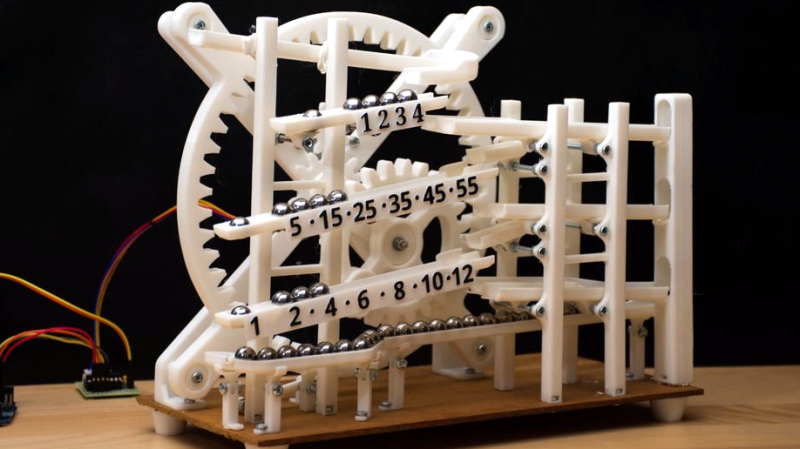There are clocks with pendulums, gears, and circuits. How about one with marbles? Initially designed in the ’70s, rolling ball clocks came in many designs and materials, but this is the future, so [gocivici] has created an Instructable to show you how you can 3D print and build your own.
Three rows of marbles keep track of the time, one for one hour intervals, one for five-minute intervals and a third for one minute intervals. It makes reading the time a bit more difficult than a pair of hands, but more fun. The clock uses the weight of the marbles to know when a row needs resetting. When the fifth marble drops onto the minute row, its weight causes the row to tilt, sending all but one marble down to the bottom of the machine. The marble that caused the tilting is sent down to the row underneath, perhaps causing a cascade of marbles down to the bottom.
There is something quite satisfying about seeing the marbles moving around in [gocivici]’s mechanical marble clock. Sure, it’s probably too loud for the nightstand, but it keeps time and looks great. In this build a stepper motor drives the main wheel which acts as an elevator, grabbing a marble from the bottom and raising it to the top to tumble down and find its position among the rows.
Of course, at Hackaday we love clocks so there have been many clock builds showcased here; all you need do is a quick search for “clock” to find some incredible designs and builds. We’ve also featured similar marble clocks.
via BoingBoing
















Rock, around the Clock.
Cool, just don’t lose your marbles.
Okay, who else was excited for 2 seconds with thinking “Whoa, now we can 3D print marble?”
it is possible, or at least close to; a quick google search yields a few results. The first one that come up is http://www.desamanera.com/en/3d-printing.aspx who offer 3D printed stone services
Form future also offers the StoneFil filaments for FDM printers https://www.formfutura.com/shop/category/composite-materials-stonefiltm-178
Actually a lot earlier than the 70s. Congreve’s rolling ball clock was invented in 1808 – it was not very accurate but still mesmerising to look at.
https://en.m.wikipedia.org/wiki/Congreve_clock
Unbelievably beautiful. The lifting mechanism doesn’t do much for the timing mechanism other than regulate the marble run to 1 Hz. But making it the visually appealing mechanism it is (does this qualify as a planetary gear?) is the brilliant part here. I also like it that this could be powered off of mains in the same way mid-century electromechanical beside clocks were.
Does anybody want to print the parts for me. I do not know anything about 3d printing. I will glady pay costs
ILL PRINT THEM FOR U
I am interest too
I was fascinate from the marble clock (from Görkem Bozkurt).
So I would linke to build my own one.
I do not have a 3d printer until now,
1 plan to buy a 3d printer, perhaps the “Prusa i3 mk3s”.
But this printer does not fit because the printing bed is only 210 mm x 210 mm instead of 250 x 250.
Is it possible to print big parts out of 2 or 4 elements and put them together?
I suppose this is a common problem. Perhaps there is a modifird set of .stl parts available?
Are there any users living in Germany like me?
Greetings from Kiel, Germany
sprotte24